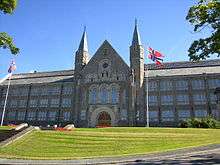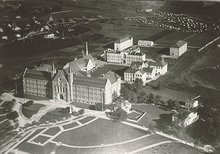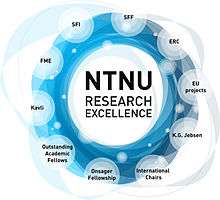Norwegian University of Science and Technology
| Norges Teknisk-Naturvitenskapelige Universitet | |
.png) | |
| Motto | Knowledge for a better world |
|---|---|
| Type | Public, Technical |
| Established | The present University was formally established in 1996,[1] on the merger of the Museum of Natural History and Archaeology, Norwegian Institute of Technology, Norwegian College of General Sciences, Trondheim Academy of Fine Art, the Faculty of Medicine (DMF) and the Trondheim Conservatory of Music (MiT) |
| Rector | Gunnar Bovim |
Administrative staff | 5,100 |
| Students | 39,000[2] |
| Location | Trondheim, Norway |
| Campus | Gløshaugen, Dragvoll, Øya, Tyholt |
| Nobel Laureates | 5 |
| Colours | |
| Athletics | NTNUI |
| Affiliations | EUA, TIME, CESAER, ATHENS, SEFI, Santander, EAIE, ESN |
| Website |
www |
The Norwegian University of Science and Technology (Norwegian: Norges teknisk-naturvitenskapelige universitet, abbreviated NTNU) is a public research university with campuses in the cities of Trondheim, Gjøvik and Ålesund in Norway. NTNU is the largest of the eight universities in Norway, and, as its name suggests, has the main national responsibility for higher education in engineering and technology. In addition to engineering and the natural and physical sciences, the university offers advanced degrees in other academic disciplines ranging from the social sciences, the arts, medicine and health sciences, teacher education, architecture and fine art.
The current rector (2013– ) is Gunnar Bovim.
History



NTNU was formed in 1996 by the merger of the Norwegian Institute of Technology (NTH), the Norwegian College of General Sciences (AVH), the Museum of Natural History and Archaeology (VM), the Faculty of Medicine (DMF), the Trondheim Academy of Fine Art and the Trondheim Conservatory of Music (MiT). Prior to the 1996 merger, NTH, AVH, DMF, and VM together constituted the University of Trondheim (UNiT), which was a much looser organization. However, the university's roots go back to 1760, with the foundation of the Trondheim Society, which in 1767 became the Royal Norwegian Society of Sciences and Letters. In 2010 the society, and NTNU, as the society's museum now is part of the university, celebrated its 250th anniversary to commemorate this history. NTNU itself celebrated the 100th anniversary of the foundation of NTH this year. The centennial was also celebrated by the publication of several books, among them a history of the university, entitled "Turbulens og tankekraft. Historien om NTNU" [3] which translates as "Turbulence and mindpower: The history of NTNU".
In 2014, the Norwegian Ministry of Education and Research asked the country's universities and university colleges to provide suggestions, observations and ideas for restructuring Norway's institutions of higher education. The context for the request was that the Norwegian government wanted to cut back on the number of institutions in the sector.
The NTNU board decided on 28 January 2015 that NTNU should merge with the University Colleges of Sør-Trøndelag, Ålesund and Gjøvik to form a new university that would retain the university's former name, the Norwegian University of Science and Technology. The merger, which went into effect in January, 2016, made NTNU into Norway's single largest university.
Campus
.jpg)
NTNU has several campuses in Trondheim, with Gløshaugen, for engineering and sciences, and Dragvoll, for humanities and social sciences as the main two. Other campuses include Tyholt for marine technology, Øya for medicine, Kalvskinnet for archaeology, Midtbyen for the music conservatory and Nedre Elvehavn for the art academy. With the 2016 merger, NTNU added campuses elsewhere in Trondheim as well as in Gjøvik and Ålesund.
NTNU has long considered the possibility of bringing the activity of the two largest campuses together at or near NTNU's Gløshaugen campus. In 2013 the Rector initiated a vision project, with the charge to define different perspectives on future development from a 50-year perspective.
That same year, 2013, the Norwegian Ministry of Education and Research initiated a choice of concept study for the future co-localization of NTNU's two main campuses in Trondheim.
The reports were presented in 2014, and both recommended bringing Dragvoll and Gløshaugen together, and better integrating them with the city. A unanimous NTNU board endorsed the recommendations in the vision report.
Organization
NTNU is governed by a board of 11 members. This is according to the Norwegian Act relating to universities and university colleges.[4] Two of the members are elected by and among the students.
Academic and administrative staff contribute 6,700 FTE of which 4053 are in education and research and 39 per cent are women. NTNU has more than 100 laboratories and is at any time running some 2,000 research projects. Students and staff can take advantage of roughly 300 research agreements or exchange programs with 58 institutions worldwide.
As of the 2016 merger, the university consists of 14 faculties and 70 departments, with approximately 39,000 students:[5]
Faculty of Architecture and Fine Art
The Faculty of Architecture and Fine Art has five departments:
- Department of Fine Art - The Trondheim Academy of Fine Art
- Department of Architectural Design, Form and Colour Studies
- Department of Architectural Design and Management
- Department of Architectural Design, History and Technology
- Department of Urban Design and Planning
Faculty of Engineering Science and Technology
The Faculty of Engineering Science and Technology has eleven departments:
- Department of Civil and Transport Engineering
- Department of Structural Engineering
- Department of Energy and Process Engineering
- Department of Marine Technology
- Department of Hydraulic and Environmental Engineering
- Department of Geology and Mineral Resources Engineering
- Department of Petroleum Engineering and Applied Geophysics
- Department of Engineering Design and Materials
- Industrial Ecology Programme
- Department of Production and Quality Engineering
- Department of Product Design
Faculty of Humanities
The Faculty of Humanities has six departments:
- Department of Art and Media Studies
- Department of Historical Studies
- Department of Interdisciplinary Studies of Culture
- Department of Language and Literature
- Department of Music
- Department of Philosophy and Religious Studies
Faculty of Natural Sciences and Technology
The Faculty of Natural Sciences and Technology has six departments:
- Department of Biotechnology
- Department of Biology
- Department of Chemistry
- Department of Chemical Engineering
- Department of Materials Science and Engineering
- Department of Physics
Faculty of Information Technology, Mathematics and Electrical Engineering
The Faculty of Information Technology, Mathematics and Electrical Engineering has six departments:
- Department of Computer and Information Science
- Department of Mathematical Sciences
- Department of Electric Power Engineering
- Department of Engineering Cybernetics
- Department of Telematics
- Department of Electronics and Telecommunications
Faculty of Medicine
The Faculty of Medicine is integrated with St. Olavs Hospital, Trondheim University Hospital, and is located in Campus Øya in Trondheim. Its main focus areas of research are translational research, medical technology and health surveys, biobanks and registers. The faculty has about 350 master’s degree students, 250 bachelor’s degree students, 720 medical students and more than 500 students attending other courses.
The Faculty of Medicine has seven departments:
- Department of Neuroscience
- Department of Public Health and General Practice
- Department of Circulation and Medical Imaging
- Department of Cancer Research and Molecular Medicine
- Department of Laboratory Medicine, Children and Women’s Health
- Kavli Institute/ Centre for Neural Computation
- Regional Centre for Child and Youth Mental Health and Child Welfare
Faculty of Social Sciences and Technology Management
The Faculty of Social Sciences and Technology Management has eleven departments:
- Department of Geography
- Department of Economics
- Department of Sociology and Political Science
- Department of Industrial Economics and Technology Management
- Department of Education
- Programme for Teacher Education
- Department of Social Work and Health Science
- Department of Psychology
- Department of Social Anthropology
- Department of Adult Learning and Counselling
- Norwegian Centre for Child Research (NOSEB)
The 2016 merger brought three new faculties and one new school to the university from the former Sør-Trøndelag University College. These are:
- Faculty of Health and Social Sciences
- Faculty of Teacher and Interpreter Education
- Faculty of Technology and the Trondheim Business School
NTNU in Gjøvik:
- Faculty of Health, Care and Nursing
- Faculty of Computer Science and Media Technology
- Faculty of Technology, Economy and Management
NTNU in Ålesund:
- Faculty of Engineering and Natural Sciences
- Faculty of Health Sciences
- Faculty of International Business
- Faculty of Life Sciences
- Faculty of Maritime Technology and Operations
Research

NTNU's overall budget in 2011/2012 was 673 million euros, most of which came from the Norwegian Ministry of Education.[6] Funding from the Research Council of Norway (NFR) totaled 82 million euros, a decrease from 2010/2011 of 4.4 percent.[7]
The university is home to four of 21 Norwegian Centers of Excellence.[8] These are the Centre for Biodiversity Dynamics, Centre for Ships and Ocean Structures,[9] the Centre for the Biology of Memory[10] and the Centre for Quantifiable Quality of Service in Communication Systems.[11] The Centre for the Biology of Memory is also one of four Kavli Neuroscience Institutes.[12] In 2012 Prime Minister Jens Stoltenberg opened the Norwegian Brain Centre as an outgrowth of NTNU's Kavli Institute [13] one of the largest research laboratories of its kind in the world.
Publishing
To increase Open Access publishing, NTNU has established a publishing fund.[14]
In 2008 NTNU's digital institutional repository was founded. The intention was to establish a full-text archive for the documentation of the scientific output of the institution, and to make as much as possible of the material available online, both nationally and internationally.
In addition to the research articles and books, intended for academics and researchers both inside and outside the university, NTNU disseminates news to the public about the institution and its research and results.
Universitetsavisa, which translates The University Newspaper, is the news and discussion paper of the university, available only in Norwegian. It was established in 1991. For a period it existed in both printed and digital editions, but since 2002 it is only available online.[15]
GEMINI publishes research news from NTNU and the independent research group SINTEF in both English and Norwegian. It is published in both a printed and a digital version.[16]
The Norwegian University of Science and Technology publishes the Nordic Journal of Science and Technology.[17]
Ranking
| University rankings | |
|---|---|
| Global | |
| ARWU[18] | 101-150 |
| Times[19] | 351-400 |
| QS[20] | 250 |
NTNU was ranked 45th in Europe and 150th in the World in January 2015 in the Webometrics Ranking of World Universities[21] for its presence on the web.
According to Top Universities Guide[22] NTNU is ranked 151st in University Subject Rankings while being among the top 246 Universities in the overall world ranking. Rankings by Subject 2014:[23]
- Engineering - Chemical: 51-100
- Engineering - Mechanical: 101-151
- Engineering - Civil and Structural: 101-151
- Mathematics: 101-151
It is ranked in top 276 universities of the world according to Times Higher Education Guide [24]
Studies

NTNU specializes in technology and the natural sciences, but also offers a range of bachelor's, master's and doctoral programmes in the humanities, social sciences, economics and public and business administration, and aesthetic disciplines. The university also offers professional degree programmes in medicine, psychology, architecture, the fine arts, music, and teacher education, in addition to technology.
According to the Norwegian Social Science Data Services, NTNU had 84,797 applicants in 2011 and a total student population of 19,054, of whom 9,062 were women. There were 6,193 students enrolled in the Faculty of Social Sciences and Technology Management, 3,518 students enrolled in the Faculty of Engineering Science and Technology, 3,256 students enrolled in the Faculty of Humanities, 3,090 students enrolled in the Faculty of Information Technology, Mathematics and Electrical Engineering, 2,014 students enrolled in the Faculty of Natural Sciences and Technology, 1,071 enrolled in the Faculty of Medicine, and 605 enrolled in the Faculty of Architecture and Fine Art.
About 3,500 bachelor's and master's degrees are awarded each year, and more than 5,500 participate in further education programmes.
NTNU has more than 300 cooperative or exchange agreements with 60 universities worldwide, and several international student exchange programmes. There are, at any given time, around 2,600 foreign students at the university.[2]
Student life

NTNU welcomes students from all over the world, and offers more than 30 master’s programmes that are taught in English. PhD programs are open to qualified applicants, and are paid staff positions that give candidates specific workplace rights and benefits under Norwegian law.
NTNU students have a clear presence in the city of Trondheim. The most famous student organization is the Studentersamfundet i Trondhjem, also known as "the red round house" after its architectural form; every other year it organizes a cultural festival UKA. Another festival organized by students is the International Student Festival in Trondheim ISFiT, which awards a student peace prize and draws internationally known speakers. EMECS-thon is a student driven embedded systems marathon competition, organized by students from NTNU and implemented in some of the top universities worldwide, where participants have 48 hours to develop an embedded project from scratch. The student sports organization, NTNUI, has roughly 10 000 members in its many branches,[25] with the largest groups including orienteering, cross-country and telemark skiing, but there are also groups for sports less common in Norway, like American football, lacrosse and aikido. A cabin and cottage organization owns several cabins in the countryside, available for students wishing to spend a few days away. There are also student fraternities, some of which conduct voluntary hazing rituals, which provide contact with potential employers and for social interaction between students. There are also alumni associations; religious and political organizations; clubs devoted to various topics such as innovation, human rights, beer, oatmeal, anime and computers; and The Association for Various Associations, which is a parody of the university's large number of student organizations. University recently started to offer "roof over your head" guarantee to new coming student to Trondheim until they find proper housing.[26]
The Gløshaugen campus of the university has been filmed with a quadcopter and may be seen as YouTube video here [27]
Nobel Laureates and notable people
Nobel Laureates
- 1968 Lars Onsager, Chemistry

- 1973 Ivar Giaever, Physics

- 2014 Edvard Moser, Medicine or Physiology

- 2014 May-Britt Moser, Medicine or Physiology

- 2014 John O'Keefe, Medicine or Physiology
 [28]
[28]
Alumni and Honorary doctors
In 2006, NTNU Alumni was founded, primarily as a meeting place and professional network for former students and staff of NTNU and its precursors. The network is now also open to current employees and students. In 2014 the number of members wa around 30,000
NTNU annually awards honorary doctorates to scientists and others who have made an extraordinary contribution to science or culture.[29]
See also
- Gemini (magazine), research news from NTNU and SINTEF
- Centre for Renewable Energy
- Trondheim, city where NTNU is located
Notes and references
- ↑ "NORWEGIAN UNIVERSITY OF SCIENCE AND TECHNOLOGY (NTNU) AT TRONDHEIM, NORWAY". EduMaritime.com. Retrieved 31 May 2015.
- 1 2 Norwegian University of Science and Technology. "Facts and figures - NTNU". Ntnu.edu. Retrieved 2016-09-10.
- ↑ Archived April 25, 2014, at the Wayback Machine.
- ↑ http://www.ub.uio.no/ujur/ulovdata/lov-20050401-015-eng.pdf
- ↑ Norwegian University of Science and Technology (2016-03-14). "Faculties and departments - NTNU". Ntnu.edu. Retrieved 2016-09-10.
- ↑ "Archived copy" (PDF). Archived from the original (PDF) on 2012-08-20. Retrieved 2012-05-11.
- ↑ "Archived copy". Archived from the original on 2011-06-15. Retrieved 2010-11-30.
- ↑ "Research Council of Norway. Norwegian Centres of Excellence". Research Council of Norway. Retrieved 2010-06-04.
- ↑ "CeSOS - Centre for Ships and Ocean Structures". Norwegian University of Science and Technology. Retrieved 2010-06-04.
- ↑ "CBM - Centre for Biology of Memory". Norwegian University of Science and Technology. Retrieved 2010-06-04.
- ↑ "Q2S- Centre for Quantifiable Quality of Service in Communication Systems". Norwegian University of Science and Technology. Retrieved 2010-06-04.
- ↑ "Kavli Institute for Systems Neuroscience". The Kavli Foundation. Retrieved 2010-06-04.
- ↑ "Norwegian Prime Minister opens brain research centre at NTNU". Norwegian University of Science and Technology. Retrieved 2012-07-15.
- ↑ Norwegian University of Science and Technology (2013-10-01). "Publishing policy - NTNU". Ntnu.edu. Retrieved 2016-09-10.
- ↑ "Universitetsavisa". Universitetsavisa.no. Retrieved 2016-09-10.
- ↑ "Gemini.no - Forskningsnyheter fra NTNU og SINTEF". Gemini.no. Retrieved 31 May 2015.
- ↑ "Editorial Policies". Nordic Journal of Science and Technology. ISSN 1894-4647. Retrieved 3 August 2016.
Nordic Journal of Science and Technology (NJSTS) is an Open Access academic journal currently published at the Norwegian University of Science and Technology.
- ↑ "Academic Ranking of World Universities: Global". Institute of Higher Education, Shanghai Jiao Tong University. 2016. Retrieved September 8, 2016.
- ↑ "World University Rankings 2016-2017". Times Higher Education. 2015. Retrieved October 22, 2016.
- ↑ "QS World University Rankings 2016/17". Quacquarelli Symonds Limited. 2016. Retrieved September 8, 2016.
- ↑ "Norway | Ranking Web of Universities". Webometrics.info. Retrieved 2016-09-10.
- ↑ "Norwegian University of Science And Technology". Top Universities. Retrieved 31 May 2015.
- ↑ "Norwegian University of Science And Technology Rankings". Top Universities. Retrieved 2016-09-10.
- ↑ "Norwegian University of Science and Technology". Retrieved 31 May 2015.
- ↑ "Archived copy". Archived from the original on 2009-05-27. Retrieved 2009-04-22.
- ↑ "Temporary housing in August". NTNU. Retrieved 26 June 2015.
- ↑ Haust @NTNU Gløshaugen. YouTube. 14 October 2013. Retrieved 31 May 2015.
- ↑ "John O´Keefe blir professor II ved NTNU -Universitetsavisa". Universitetsavisa.no. Retrieved 2016-09-10.
- ↑ "Archived copy". Archived from the original on 2014-11-29. Retrieved 2014-11-19.
External links
- Official website
- NTNU - facts and figures
- An overview of some of NTNU’s laboratories
- An overview of the campus in Gløshaugen
Coordinates: 63°25′10″N 10°24′9″E / 63.41944°N 10.40250°E